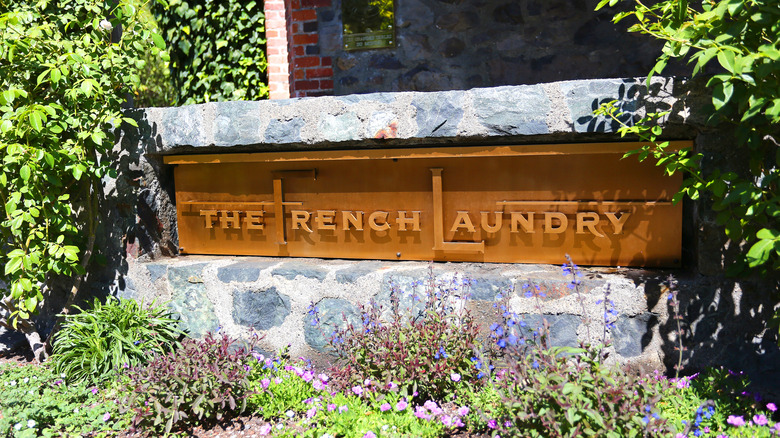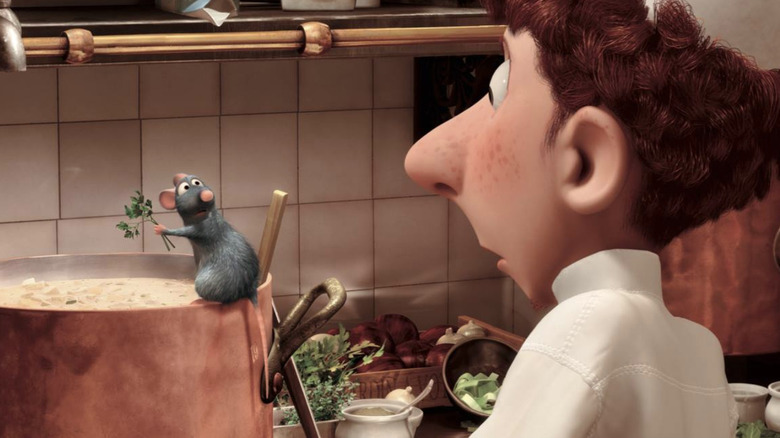The Influential Way Thomas Keller Contributed To The Film Ratatouille
Even in food-forward films, it's unusual for a recipe to be a primary player. We're hard–pressed to think of any movie that left us with the thought, "I have to get that recipe" — except the 2007 animated film, "Ratatouille." What distinguishes this film about cooking is the fact that the character responsible for crafting the recipe is a rat named Remy, who, despite being able to cook better than anyone else in the film, is still a rat. But contrary to film lore, it wasn't the animated chef Gusteau that taught Remy to cook, but real-life Michelin-star chef Thomas Keller (via The New York Times).
In short, "Ratatouille" chronicles the adventures of a French rat with a sophisticated palate who dreams of becoming a world-class chef (via IMDb). The obvious conundrum? Food inspectors aren't known to be fans of rats in kitchens. But fate intervenes, and Remy the rat ends up restoring the reputation of Gusteau's, a once award-winning Parisian eatery that fell on hard times after the death of its chef-owner. The dish that saves the day: ratatouille. One thing that set "Ratatouille" apart from most animated movies is the effort the production put into the verisimilitude of cooking. According to The New York Times, the studio had a lofty goal — they wanted the animation to be so on point that when movie-goers left the theater, they could imagine themselves right back in the restaurant the animators depicted on the big screen.
Real-world experience inspired the animation
That's where Thomas Keller entered the picture. In addition to recruiting Keller to acquaint the film's production crew with the inner workings of a Michelin-star kitchen, Disney-owned Pixar Animation Studios also asked the award-winning chef to create a true-to-life menu for the fictional Parisian restaurant portrayed in the film. According to The New York Times, the crew went to work at Keller's Michelin-star Napa Valley restaurant, The French Laundry. Under Keller's watchful eye, they sliced, diced, and chopped their way through prep, picking up experiences and nuances they could apply to the animation process. (We can only hope the Pixar crew also picked up a few cooking tips they could use at home, but that's a question for another day.)
In the movie, the animated characters create crave-worthy dishes like steamed pike with butter, braised fennel, and heirloom potatoes, as well as grilled petit filet mignon with oxtail and baby onion ragout topped with truffled bordelaise and shaved Périgord truffle. The New York Times noticed a few instances where the crew's pre-production training likely enhanced animation — steam rising from a pot of soup and the way sliced leek fell from a knife. There were some unexpected challenges, too. Apparently, it's tough to create realistic animated renderings of simple green vegetables — the depiction can easily lean too minty or too limey. Sharon Calahan, director of photography and lighting, told The New York Times, "Lettuce was really challenging. Your brain knows what color lettuce is."
The ratatouille secret revealed
According to The New York Times, Thomas Keller's influence is particularly evident in the movie's depiction of the titular dish. To get it just right, a crew filmed Keller making the dish, catching a last-minute tweak that, when interpreted via animation, became a stand-out moment in the film. Keller picked up a row of sliced vegetables to add to the skillet. When it collapsed between parchment paper and pan, he made a split-second decision to fan the vegetables out accordion-style. "I realized at that moment how the dish would come together," Keller told the Times.
If you'd like to try your hand at the dish, Keller lays out in detail his recipe for Remy's Ratatouille for The Berkshire Eagle. The famous signature look for the dish (the one that caught the animators' attention) lies in his instruction to "arrange alternating slices of overlapping vegetables down the center while leaving a ¼-inch of each slice exposed. Then layer the rest of the vegetables in a spiral toward the middle of the pan, creating a central mound." Lay a single chive over a portion of the masterpiece, and voila!


